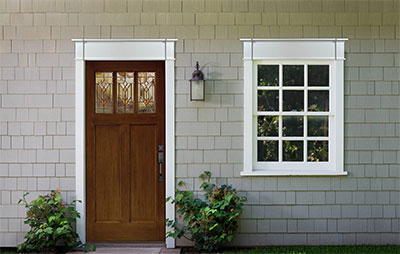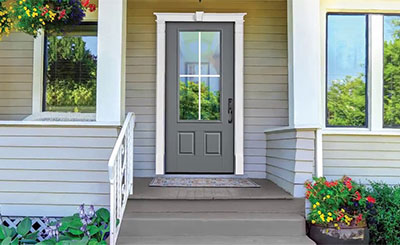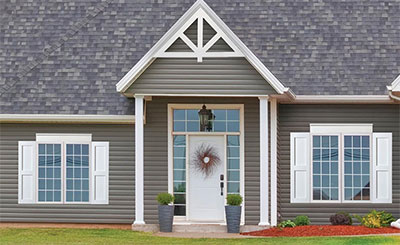Choosing the Right Crossheads for Your Home
by Rachel Lyon, Editorial Director for The House Designers®
When it comes time to put the finishing touches on your new home, don’t forget that a few key exterior features go a long way toward excellent curb appeal. But if you use the wrong style, your home will look strange and unbalanced. Here are some different kinds of crossheads—the top part of window and door frames—that can make your home stand out for the right reasons!
The new
Craftsman Cove Crosshead has the look of a historical wood built-up crosshead with cove and top trim, but it won’t fall prey to rot or insects thanks to its polyurethane construction.
Craftsman Crossheads
As a popular type of architecture that pays particular attention to finer finishing details, Craftsman design makes the most of millwork. That includes crossheads, and because there is a lot of variation between Craftsman homes, there’s a range of styles to consider. This trim tries to find a way to decorate without overcomplicating the exterior design, so it tends toward wide, flat pieces to draw the eye and then gives them some kind of old-fashioned flair.
You can identify a good Craftsman crosshead by its width and mostly square shapes. Vertical or horizontal lines suggesting carved or added-on pieces are minimal and limited to the edges of the crosshead. The goal is to get something that looks like it was created using wood, basic tools, and traditional workmanship.
A traditional crosshead has plenty of finer details but needn't be overpowering. Delicate flaring and a small keystone are the perfect choice for this covered entry. If you’re looking for a quick and easy upgrade for your front door, you’ll find it in a
Door Surround Kit.
Traditional Crossheads
While “traditional” seems like a catch-all term, we use it to cover formal designs that pull from history, including colonial, Victorian, and Southern styles. These homes tend to be stately in their decoration as opposed to the humbler Craftsman. Trim can be flat or fluted and thick or thin, and crossheads are no exception. The variety stems from the space available in addition to the amount of visual interest already provided by the rest of the house. Federal-style structures are plain, blocky, and rely on the contrast of their trim for balance, while intricate Victorians usually opt for simpler trim around windows and doors so their porch and eave ornamentations stand out.
A traditional crosshead has texture across its width. Smoothly carved lines that dip in and bulge out are common, and dentil block patterns are also seen on older classic homes. These features can be across the whole height of the crosshead or just the upper portion, but the most distinguishing characteristic is the overall shape, which flares up and out to the sides as opposed to being square. To draw the eye, keystones that stand out from the midpoint are a nice formal touch. Homes with flat façades also sometimes have a pediment on top for an extra dose of grandiosity.
The Craftsman Stepped Crossheads over these windows add simple, traditional Arts and Crafts flair while the front door is surrounded by wide sidelites and a transom window for a bright and informal façade. This arrangement is suitable for simply styled homes, like
ranch or
country designs.
Simple Crossheads
When you have a home that doesn’t call for a particularly bold or specific exterior design, there are still plenty of options. Some people use plain trim pieces for all of their windows and doors, but proper crossheads put more oomph into the look. Even simple crossheads accent and enhance, so explore a catalog and you’ll find plenty of understated and totally suitable possibilities. Most will—albeit subtly—tend toward one type of architectural style, but the effect won’t be overpowering if you choose wisely. Many homeowners appreciate the extra subtle touch as a way to make their homes unique and pay homage to another favorite style, like adding a bit of Craftsman flair to a farmhouse.
The possibilities for crossheads are practically endless, but help to find the perfect ones is available. Take a look at this Style Selection information to get a better idea of your home’s architecture and how to dress it up. Fypon® currently has almost a thousand different crossheads in their catalog, and they offer a free takeoff service if you want expertly selected products for your exact home. If you want something truly unique, they also do custom work. No matter what you choose, Fypon’s® water- and insect-resistant polyurethane provides durable and maintenance-free style that will have your home looking its best for many years. Use their dealer locator to get started today!



.png)
.png)




